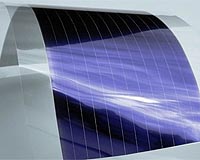 |
Berlin (UPI) Jan 12, 2011 Fearing a painful cap on subsidies at the start of next year, the German solar power industry has approached the German government for discussions on voluntary feed-in tariff reductions taking effect this summer. The industry lobbying group BSW is ready to accept a reduction of subsidies for rooftop installations "by up to 12 percent" as early as July, BSW head Carsten Koernig told Wednesday's Berliner Zeitung newspaper. BSW is a solar industry lobbying group. This comes after a record 2010, when an estimated 10 gigawatt of solar capacity, the equivalent of 10 large coal-fired power plants, was installed in Germany. In 2009, 4 GW were installed. While it's unusual that a lobbyist proposes a funding cut, Koernig says he knows that last year's solar power boom has damaged his industry's standing with the government and ordinary Germans. Because the renewable energy feed-in tariff is paid by German taxpayers via their electricity bills, the 2010 solar module sales record has driven up power prices. The so-called eco-tax jumped from 2 cents to 3.5 cents per kilowatt-hour at the start of this year. As subsidies are guaranteed for 20 years, Germany faces billions of dollars in costs for decades to come. This didn't come as a complete surprise. After prices for cells roughly halved in the past two years, Berlin in early 2010 agreed to reduce subsidies for rooftop panels by 16 percent. The decision was in part responsible for the sales boom, as private customers ordered panels in droves to beat feed-in-tariff reductions set for July. The next reduction of subsidies is set for early 2012 and senior government officials have talked about capping the total amount of money spent on new solar installations. The industry wants to prevent a cap at all cost and has approached the government about a 12 percent cut to take effect in July, six months earlier than planned. Berlin is expected to agree; the exact reduction will depend on how the market develops early this year, Koernig told the Berliner Zeitung. Analysts are divided when it comes to the overall prospects for the solar power market. Market research firm iSuppli said it expects global solar power installations to rise from 16 GW to 19 GW this year -- despite an inevitable drop in Western Europe. Yet Gordon Johnson, a solar sector analyst with Axiom Capital Management, called the 2010 boom "a bubble" that is poised to deflate. "Many analysts say third countries will be able to compensate for the sales drop in the German market," Johnson told German finance magazine Der Aktionaer. "I don't believe that. After all, Germany accounted for almost 70 percent of the global market in the first half of 2010." The state of the German market could result in a takeover spree and even bankruptcies, consultancy Roland Berger has warned. It expects only half of Germany's 50 major solar energy companies to survive the accelerating price war in the photovoltaic industry. Because of a "threefold threat of low-cost competition from Asia, declining sales at home and a dwindling presence in the world's growth markets" many German firms will have to offshore their production to low-cost regions or face bankruptcy, the analysts wrote last year. Shares of former industry giants such as Q-Cells and Conergy, once the world's largest cell producer and Germany's largest solar energy company, respectively, in 2009 and 2010 plummeted to all-time lows. While both firms have performed stronger recently, they remain at risk of being gulped or going under, observers say.
Share This Article With Planet Earth
Related Links All About Solar Energy at SolarDaily.com
 Debunking Solar Energy Efficiency Measurements
Debunking Solar Energy Efficiency MeasurementsNew York NY (SPX) Jan 11, 2011 In recent years, developers have been investigating light-harvesting thin film solar panels made from nanotechnology - and promoting efficiency metrics to make the technology marketable. Now a Tel Aviv University researcher is providing new evidence to challenge recent "charge" measurements for increasing solar panel efficiency. Offering a less expensive, smaller solution than traditional ... read more |
|
| The content herein, unless otherwise known to be public domain, are Copyright 1995-2010 - SpaceDaily. AFP and UPI Wire Stories are copyright Agence France-Presse and United Press International. ESA Portal Reports are copyright European Space Agency. All NASA sourced material is public domain. Additional copyrights may apply in whole or part to other bona fide parties. Advertising does not imply endorsement,agreement or approval of any opinions, statements or information provided by SpaceDaily on any Web page published or hosted by SpaceDaily. Privacy Statement |